Neural network resemblance in biological and internet

My work now is best disecribe as a mix of biology, optical analysis, and chemistry. And I had to thank a lot of people for providing the opportunity in this demanding task. To think about neural network, it is more complicated than any internet routing algortihm. In fact, the routing mechanism derived teminologies from biological network of neurons, vice versa. (c) Anton Rahmadi. title: neurite extensions as communication means of neurons. Image was recorded with optical maginification of 400x and fluorescent green emission/excitation. Here are some resemblances: (1) burst signal (2) delay input and synchronization (3) spike . Scientists are now developing algorithm to understand and mimick neuronal signal. Djiksra algorithm , a.k.a shortest path routing , being employed as an approach to biological neuron communication , other advanced mechanisms are also utilized. To understand behaviour of healthy and impaired neuronal network (which is now a part of my task) is coincidently coll


